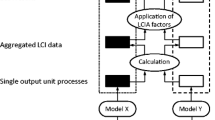Abstract
Network losses and returns are importantissues for water resource management, that are addressed in thispaper by modeling the structure of production for municipal waterutilities with two outputs: water sold to final customers andwater network losses. We propose a measure of economies of scopeto assess the benefit associated with joint production of waterfor final customers and water losses, and several measures ofreturns to evaluate potential gains in exploiting technologicalflexibility of water networks. We estimate the cost structureof water utilities using a GMM procedure with a Translog costfunction and panel data. Estimation results reveal a positivedegree of economies of scope, and short-run returns to productiondensity and returns to customer density that are not significantlydifferent from 1. Significant economies of scale indicate thatlocal communities may benefit from merging into water districts.
Similar content being viewed by others
References
Amemiya, T., and T. MaCurdy. (1986). “Instrumental-Variable Estimation of an Error-Components Model.” Econometrica 54(4), 869–880.
Bailey, E. E., and A. F. Friedlaender. (1982). “Market Structure and Multiproduct Industries.” Journal of Economic Literature 20(3), 1024–1048.
Baumol, W. J. (1977). “On the Proper Cost Tests for Natural Monopoly in a Multiproduct Industry.” American Economic Journal 67(5), 809–822.
Bhattacharyya, A., T. R. Harris, R. Narayanan, and K. Raffiee. (1995). “Specification and Estimation of the Effect of Ownership on the Economic Efficiency of the Water Utilities.” Regional Science and Urban Economics 25, 759–784.
Binswanger, H. P. (1974). “A Cost Function Approach to the Measurement of Elasticities of Factor Demand and Elasticities of Substitution.” American Journal of Agricultural Economics 56(1), 377–386.
Blackorby, C., and R. R. Russel. (1989). “Will the Real Elasticity of Substitution Please Stand Up? (A Comparison of the Allen/Uzawa and Morishima Elasticities.” American Economic Review 79(4), 882–888.
Breusch, T., G. Mizon, and P. Schmidt. (1989). “Efficient Estimation Using Panel Data.” Econometrica 57(3), 695–700.
Caves, D. W., L. R. Christensen, and J. A. Swanson. (1981). “Productivity Growth, Scale Economies, and Capacity Utilization in U.S. Railroads, 1955–74.” American Economic Review 71(5), 994–1002.
Chambers, R. G. (1988). Applied Production Analysis: A Dual Approach. Cambridge University Press.
Christensen, L. R., D. W. Jorgenson, and L. J. Lau. (1973). “Transcendental Logarithmic Production Frontiers.” Review of Economics and Statistics 55, 28–45.
Cornwell, C., P. Schmidt, and D. Wyhowski. (1992). “Simultaneous Equations and Panel Data.” Journal of Econometrics 51, 151–181.
Cowing, T. G., and A. G. Holtmann. (1983). “Multiproduct Short-Run Hospital Cost Functions: Empirical Evidence and Policy Implications from Cross-Section Data.” Southern Economic Journal 49(1), 637–653.
Crain, W. M., and A. Zardkoohi. (1978). “A Test of the Property-Rights Theory of Firm: Water Utilities in the United States.” Journal of Law and Economics 21(2), 395–408.
Davies, G. (1968). “Trunk Pipeline Selection--What Size and When.” Journal of the Institution of Water Engineers 22, 281.
Diewert, W. E., and T. J. Wales. (1987). “Flexible Functional Forms and Global Curvature Conditions.” Econometrica 55(1), 43–68.
Ford, J. L., and J. J. Warford. (1969). “Cost Functions for the Water Industry.” Journal of Industrial Economics 18(1), 53–63.
Gironde, DDAF. (1995, 1996, 1997). “Technical and Financial Reports on Private Water Utilities in Gironde.” International Documents.
Hansen, L. (1982). “Large Sample Properties of Generalized Method of Moment Estimators.” Econometrica 50(4), 1029–1054.
Hausman, J., and W. Taylor. (1981). “Panel Data and Unobservable Individual Effects.” Econometrica 49(6), 1377–1398.
Hayes, K. (1987). “Cost Structure of the Water Utility Industry.” Applied Economics 19, 417–425.
Kim, H. Y. (1987). “Economics of Scale in Multiproduct Firms: An Empirical Analysis.” Economica 54(214), 185–206.
Kmenta, J. (1986). Elements of Econometrics, second edition. New York: Macmillan Publishing Company.
Laffont, J.-J., and J. Tirole. (1993). A Theory of Incentives in Procurement and Regulation. Cambridge, MA: MIT Press.
Morishima, M. (1967). “A Few Suggestions on the Theory of Elasticity.” Keiza Hyoron (Economic Review) 16, 144–50. (In Japanese).
Nemoto, J., Y. Nakanishi, and S. Madono. (1993). “Scale Economies and Over-Capitalisation in Japanese Electric Utilities.” International Economic Review 34(2), 431–440.
Panzar, J. C. (1989). “Technological Determinants of Firm and Industry Structure.” Chap. 1 in R. Schamalensee and R. D. Willig (eds.), Handbook of Industrial Organization, Vol. 1, Elsevier Science Publishers B. V.
Panzar, J. C., and R. D. Willig. (1997). “Economies of Scale in Multi-Output Production.” Quarterly Journal of Economics 91(3), 481–493.
Renzetti, S. J. (1992). “Evaluating the Welfare Effects of reforming Municipal Water Prices.” Journal of Environmental Economics and Management 22. 147–163.
Roberts, M. J. (1986). “Economies of Density and Size in the Production and Delivery of Electric Power.” Land Economics 62(4), 378–387.
Salvanes, K. G., and S. Tjotta. (1994). “Productivity Differences in Multiple Output Industries: An Application to Electric Distribution.” Journal of Productivity and Analysis 5(1), 23–43.
Schankerman, M., and M. I. Nadiri. (1986). “A Test of Static Equilibrium Models and Rates of Return to Quasi-Fixed Factors, with an Application to the Bell System.” Journal of Econometrics 33, 97–118.
Schmidt, P. (1990). “Three-Stage Least Squares with Different Instruments for Different Equations.” Journal of Econometrics 43, 389–394.
Teeples, R., and D. Glyer. (1987). “Production Function for Water Delivery Systems: Analysis and Estimation Using Dual Cost Function and Implicit Price Specifications.” Water Resources Research 23, 765–773.
White, H. (1980). “Using Least Squares to Approximate Unknown Regression Functions.” International Economic Review 21(1), 149–170.
Zellner, A. (1962). “An Efficient Method of Estimating Seemingly Unrelated Regression and Test for Aggregation Bias.” Journal of the American Statistical Association 58, 348–368.
Author information
Authors and Affiliations
Rights and permissions
About this article
Cite this article
Garcia, S., Thomas, A. The Structure of Municipal Water Supply Costs: Application to a Panel of French Local Communities. Journal of Productivity Analysis 16, 5–29 (2001). https://doi.org/10.1023/A:1011142901799
Issue Date:
DOI: https://doi.org/10.1023/A:1011142901799




